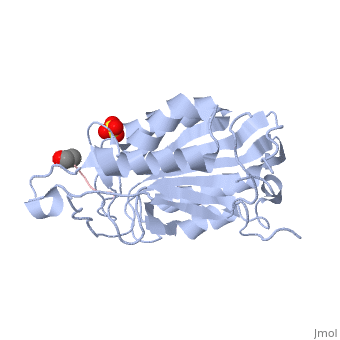Maureen E. Hill/Sandbox1
From Proteopedia
(Difference between revisions)
| Line 21: | Line 21: | ||
It has been shown that caspases -3 and -7 can be inhibited at a site other than the active site by allosteric inhibitors, such as 5-Fluoro-1H-indole-2-carboxylic acid (2-mercapto-ethyl)-amide ('''FICA''') or 2-(2,4-Dichlorophenoxy)-N-(2-mercapto-ethyl)-acetamide ('''DICA'''), at the dimer-interface cavity. The mechanism of these inhibitors lock the L2' in a down conformation, thereby inactivating the enzyme. | It has been shown that caspases -3 and -7 can be inhibited at a site other than the active site by allosteric inhibitors, such as 5-Fluoro-1H-indole-2-carboxylic acid (2-mercapto-ethyl)-amide ('''FICA''') or 2-(2,4-Dichlorophenoxy)-N-(2-mercapto-ethyl)-acetamide ('''DICA'''), at the dimer-interface cavity. The mechanism of these inhibitors lock the L2' in a down conformation, thereby inactivating the enzyme. | ||
| - | <scene name='56/566502/Dica_bound_caspase_7/2'>Caspase-7 bound to allosteric inhibitor DICA</scene> at the dimer interface. The allosteric inhibitor binds to C290 within the dimer interface displacing Y223. The displacement of tyrosine from the active site conformation of the enzyme forces R187 into a position that both physically blocks substrate binding | + | <scene name='56/566502/Dica_bound_caspase_7/2'>Caspase-7 bound to allosteric inhibitor DICA</scene> at the dimer interface. The allosteric inhibitor binds to C290 within the dimer interface displacing Y223. The displacement of tyrosine from the active site conformation of the enzyme forces R187 into a position that both physically blocks substrate binding and moves the active site cysteine 186. Ultimately, these conformational changes inactivate the enzyme. |
Revision as of 15:47, 3 December 2013
Caspases are a family of CBI Molecules being studied in the University of Massachusetts Amherst Chemistry-Biology Interface Program at UMass Amherst and on display at the Molecular Playground.
Executioner Caspase-7
| |||||||||||

